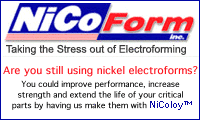world gathers for metal finishing
Q&As since 1989
-----
Reducing the throwing power of Nickel sulphamate solutions
I am trying to reduce the throwing power of sulphamate Nickel bath. I am electroforming on grooved rollers so that they can be machined to original dimensions. The job requires that maximum nickel is deposited on the top of the grooves to get the required dimensions. The bottom of the grooves also get nearly the same thickness. This is not desired as there is no wear and tear at the bottom of the grooves and this deposited nickel has to be removed by machining. Is there a way to reduce the throwing power of the solution so that maximum deposit is on the top of the grooves and minimum at the bottom. The grooves are 0.2 mm in height and the interelectrode distance is 100 mm. The solution is 350 gpl nickel sulphamate and the current density is 10 Amp per sq dm.
Nitin Kibe- Pune, India
1999
I doubt that there is really an effective practical way to reduce the throwing power significantly, but the theoretical factors are:
- Low solution concentrations increase throwing power (by starving the HCD areas), so high concentration should reduce it.
- Low temperatures increase throwing power the same way, so high temperature should reduce it.
- Good agitation reduces throwing power.
But it really sounds to me like a mechanical means of altering the local current density will prove more effective: possibly plastic shields over the groove area to make the current path much longer, possibly auxiliary anodes where you want the greatest buildup.

Ted Mooney, P.E.
Striving to live Aloha
finishing.com - Pine Beach, New Jersey
Your problem is nearly the opposite of most people's.
There are two kinds of throwing power, macro and micro.Yours problem is micro or the reverse of micro.
I will disagree with Ted on this one. The warmer the solution the better it plates into recesses. I used 130F because that is the point of least internal stress, which was a significant concern of most of my plating.
Excellent agitation allows better plating in the recesses because it reduces the diffusion distance.
My suggestion is to gradually increase your current density until you find an value that is overall acceptable. This works because the peak of the thread is a significantly higher current density area than the valley of the thread.Next, I would reduce the agitation in very small increments. I would also consider moving your anodes a little further away.
There are a lot of variables to play with until you find the optimum.
- Navarre, Florida
1999
Nitin, I remember reading some studies suggesting that periodic-reverse (PR) plating had a negative effect on throwing power in sulfamate nickel, you may want to look into this. Another idea that the geometry of your parts suggests is to plate the parts in the position 'ribs down, grooves up' at a slight (15-30 deg.) angle. Use a source of clean air (from an oil-less blower, not a compressor) at the lower edge of your parts so that air bubbles travel up the inverted grooves of the components essentially blocking groove bottoms from plating, while the ribs will still plate OK. Good luck and let us know how things work out for you,

"PlaterB" Berl Stein
NiCoForm, Inc.
Rochester, New York

1999
Try to use a higher current and use a low agitation. When you use a low current the bath get a better distribution. That should work. Regard Anders S

Anders Sundman
4th Generation Surface Engineering
Consultant - Arvika,
Sweden
August 13, 2010
Hello guys,
I'm from an electromechanics company and is relatively new to plating.
Regarding the problem... How about lessening agitation and placing the anode only on the side where thicker Nickel plating is desired. Will it work? :)
- Manila, Philippines
1999
Q, A, or Comment on THIS thread -or- Start a NEW Thread
